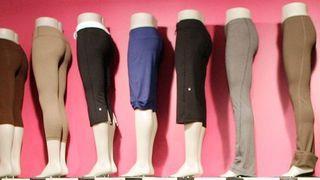Last week's post discussed a study by the Canadian Women's Foundation, which highlighted the disproportionate number of young girls (ages 9-16) who described themselves as fat, or as being on a diet, or thought of themselves as ugly. In each of those categories the girls outnumbered the boys by an average of 3 to 1.
In a recent interview Beth Malcolm, Director of the Girl’s Fund at the Canadian Women’s Foundation, went into greater detail with me as to why young girls develop such feelings of shame in reference to themselves. She also offered some advice for parents to help counteract the development of self-scrutiny in children as young as 5-years-old.
 "The advertising is there all the time about lose weight, lose weight, lose weight."
"The advertising is there all the time about lose weight, lose weight, lose weight."
CHILDREN PICK UP ON PATTERNS AT HOME & ONLINE
Weight and beauty have become such focuses of our daily lives, and such a part of mass-media, that making passing comments about our own body image, or poor nutrition, has become part of our daily lexicon. Ms. Malcolm points out how that kind of flippant bombardment registers very easily with young girls, and quickly leaves an impression:
"Kids hear parents talking about 'I need to cut back on this', or 'I need to diet this way'...They are hearing it from the adults in their lives, as well as the advertisement that’s out there. Even for the kids who are on Facebook, there are ads popping up all the time targeted to them. The advertising is there all the time about 'Lose weight, lose weight, lose weight'."
 "The mannequins are size 4 and 6, and lots of kids aren’t that size. They try on the clothes that they thought looked great on the mannequin, and they don’t look that great (on themselves)."
"The mannequins are size 4 and 6, and lots of kids aren’t that size. They try on the clothes that they thought looked great on the mannequin, and they don’t look that great (on themselves)."
BODY-IMAGE BOMBARDMENT CAN LEAD TO DISORDERED THINKING
This type of constant bombardment can create a fixation which can threaten a young girl's physical and mental health to the point of creating a disorder. She referred to a McCreary Centre Society study which found that 60% of girls who were objectively evaluated as being too thin, described themselves as being 'fat'.
"That’s an extreme example of what kids are facing on a regular basis in terms of magazines and billboards and videogames...and even the clothing they buy. Even when they go into store, the mannequins are size 4 and 6, and lots of kids aren’t that size. They try on the clothes that they thought looked great on the mannequin, and they don’t look that great (on themselves). But rather than questioning ‘Well, wait, that mannequin was exceptionally thin', they start to criticize themselves and be to critical of their own bodies."
HOW DO YOU TEACH YOUNG WOMEN TO THINK CRITICALLY?
Being at such an impressionable age, it is vital all young people--and especially young women who are most affected by these messages--learn to understand how the message is being manipulated. For many of them, they are unaware of advertisers' Photoshopping and airbrushing of images, which creates unrealistic expectations in their young readers.
Ms. Malcolm explained how one of her friends agreed to allow her 12-year-old daughter to subscribe to a teen magazine under the condition the two of them would sit down and look through each issue together. Her friend acknowledged that, should she refuse the subscription, her daughter would resort to reading these publications outside the home with her friends. She realized this was an opportunity to take control of a situation and use it to teach her daughter think critically.
 "I think it’s being honest with your kids. When you put on a snowsuit you tend to look large, you can’t help it. But you can change the language a little bit."
"I think it’s being honest with your kids. When you put on a snowsuit you tend to look large, you can’t help it. But you can change the language a little bit."
HOW TO YOU BEGIN BODY-IMAGE DISCUSSIONS WITH VERY YOUNG CHILDREN?
The CWF study specifically dealt with girls aged 9-16. How do you approach such an abstract topic with an even younger girl? I was particularly interested in some guidance; my 6-year-old daughter had recently commented on how her snowsuit made her look fat.
"I think it’s being honest with your kids. When you put on a snowsuit you tend to look large, you can’t help it. But you can change the language a little bit.
You can say 'You don’t look fat, the snowsuit makes you look larger.' You have to be honest. If they say they look fat in their snowsuit, you can talk about 'Yeah, but you are really special inside. You have this strength or that strength’ or ‘You’re amazing at this activity.’
You can shift the language. You don’t have to get into a whole lecture about body image or body weight, because they're 6."
 "They would turn entertainment into an opportunity to learn about unrealistic body image portrayals for the purposes of entertainment."
"They would turn entertainment into an opportunity to learn about unrealistic body image portrayals for the purposes of entertainment."
MAKE CRITICAL THINKING PART OF EVERYDAY LANGUAGE
Even better than using that type of encouragement solely as a defense against self-deprecating comments. Ms. Malcolm suggests a preventative measure of teaching your children to have a realistic profile of their real-word surroundings on a daily basis.
"When you’re walking around, or at the movies, show them that people come in all shapes and sizes.
I think it’s important to shift that language and talk about getting more active or eating healthy."
She referred to two books by Lyn Mikel Brown & Sharon Lamb: "Packaging Girlhood" and "Packaging Boyhood" (also with Mark Tappan). She relayed how Ms. Brown, one of the authors, once told her how some of the most poingnant conversations between her and her daughter took place while watching a movie or a television show. They would turn entertainment into an opportunity to learn about unrealistic body image portrayals for the purposes of entertainment.
PARENTS SHOULD LEARN WHAT TO TALK ABOUT & WHAT TO STOP SAYING
Ultimately, Ms. Malcolm says, it's up to parents to be more aware of their own language patterns, while at the same time teaching their children not to fixate on the unrealistic messages from outside the home.
"Accept who you are and how you look and stop being critical of yourself. It’s probably a long slow shift we have to make. We have to teach kids to be critical about what they’re seeing and maybe turn off the TV at that time...You have to listen to the kids and let them take the lead. Really listen to what they’re saying and you’re going to start to hear things. As you start to hear things, have the conversation when they come up.
That’s the big challenge: kids have to understand that what they’re seeing isn’t necessarily real."

